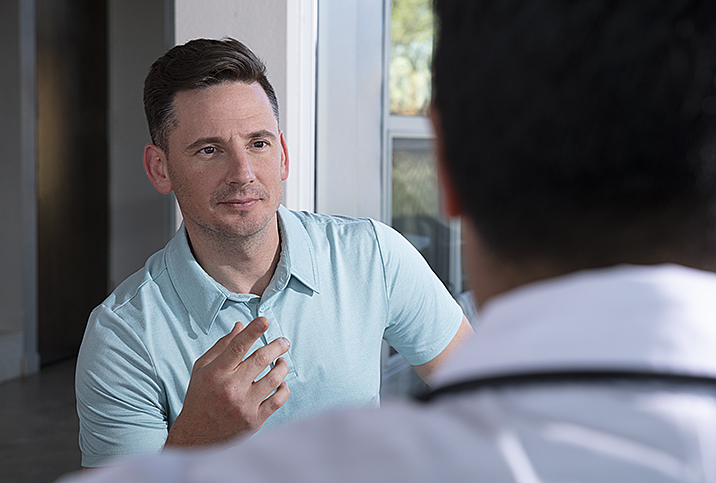It's Time to Seek Professional Help if You Have These HPV Symptoms

The human papillomavirus (HPV) is the most common and widely prevalent sexually transmitted infection (STI) in the United States, according to the Centers for Disease Control and Prevention (CDC).
It's estimated that more than 40 percent of adults ages 18 to 59 have genital HPV, and 7 percent have oral HPV. There are about 14 million new infections each year, and medical experts believe at least 80 percent of sexually active people will get human papillomavirus at some point.
For the most part, HPV is harmless and rarely shows any outward symptoms, because the immune system naturally fights off infections and gets rid of viruses.
"Usually, there are no symptoms," according to Laurence Gerlis, M.A., M.B., the CEO and lead clinician at SameDayDoctor, a private general practitioner practice with clinics in London and Manchester in the United Kingdom. "Most of us catch HPV in our teenage years and our immune systems deal with [it]."
Human papillomavirus has successfully invaded our population and continues to spread rapidly. However, the vast majority of people with HPV are asymptomatic, completely unaware their system has been breached, because our immune response can work behind the scenes to quietly suppress the infection.
Our bodies are capable of phenomenal functions, especially when faced with STIs such as human papillomavirus. Unfortunately, immunocompromised people, such as those with HIV, tend to have a harder time eliminating the virus, which can lead to prolonged infection. If a high-risk human papillomavirus variant remains in the system for a long period of time, the risk of developing cancer increases.
For example, women with HIV are six times more likely to develop cervical cancer, according to the World Health Organization (WHO). Additionally, a 2017 study published in the Asian Pacific Journal of Cancer Prevention revealed that types 16 and 18 of HPV are the major causes of cervical cancer worldwide.
If symptoms show up, they can manifest in a variety of ways depending on the specific variant of human papillomavirus. But keep in mind that there are more than 100 different types of HPV and these are typically categorized into low-risk and high-risk variants.
Signs and symptoms
HPV infects epithelial tissue, which covers the skin, bodily cavities and mucous membranes; this is why symptoms can appear in a variety of areas around the body. The most common symptom of an HPV infection is the appearance of warts and these are typically associated with low-risk variants, that is, those that don't lead to any cancer risks.
"The most common symptom of HPV is developing warts," said Babak Ashrafi, M.B.B.S., B.Sc., from Superdrug Online Doctor, based in the U.K. "These can be genital warts or warts on many other parts of the body. There are different types of warts, including common warts, verrucas and genital warts."
According to Monte Swarup, M.D., a board-certified OB-GYN in Arizona and founder of HPD Rx, warts may vary in appearance depending on the strain of human papillomavirus:
- Genital warts. In women, on the vulva, anus or cervix. In men, on the penis, scrotum and around the anus.
- Common warts. On the hands and fingers.
- Flat warts. In men, on the face. In women, on the legs.
- Plantar warts. On the heels and balls of the feet.
"The other, less common, symptom is cancer. [HPV] can cause changes in the tissue of the part of the body infected and lead to cancerous changes," Ashrafi added. "The most common type of cancer caused by HPV is cervical cancer. This can cause symptoms like abnormal bleeding, bleeding after sex or pelvic/vaginal pain."
Diagnosis and testing
If you've experienced any of the symptoms mentioned and suspect an HPV infection, it's best to consult your healthcare provider. But remember there's no screening necessary for warts.
"There are lots of different types of treatment for warts, and the diagnosis is made by identifying a wart," Ashrafi noted.
There is also no approved test to find human papillomavirus in the mouth. However, there are cervical cancer screening tests in the U.S., according to Robyn Faye, M.D., an OB-GYN in Pennsylvania and a member of the HealthyWomen Women's Health Advisory Council.
She added that healthcare providers only use these tests for screening women ages 30 and older, and not for men, adolescents or women younger than 30.
Since a lot of people with HPV are asymptomatic, it's important to get screened regularly to look for abnormalities and track issues before cancer has a chance to develop.
According to Swarup, the most common tests for HPV are the Pap test and the HPV test. These tests are done the same way, by gently scraping or brushing the cervix and removing cells that are used for testing.
- HPV test. Looks for high-risk HPV. These are the strains of HPV that are more likely to cause cancers and precancer of the cervix. This test can be done at the same time as a Pap test.
- Pap test. Looks to find abnormal cells or cell changes in the cervix.
You can also opt for a colposcopy, which looks at the cervix for very small abnormalities.
If you have reservations about testing for human papillomavirus, bear in mind there are possible health consequences if you don't get tested.
"Testing can often feel quite invasive, but it's definitely worth it as not testing can lead to HPV going undetected, which can cause negative health outcomes," said Melanie Bone, M.D., an OB-GYN and a member of the medical board for Daye, a gynecological health company based in London.
"Countries need to be more innovative in this space and consider less invasive ways of HPV testing, like the at-home HPV testing deployed in Canada and Australia," she continued. "Clinic tests might involve wait times, and it is necessary to undress and have a speculum inserted into the vagina, which some women don't mind, but others find invasive and overwhelming.
"Countries like Australia and Canada are moving to at-home HPV testing to replace the Pap smear, so better times for screening are coming," Bone said.
Myths and misconceptions
A lot of myths and misconceptions about human papillomavirus have permeated society, and it's imperative to dismantle these harmful ideas to encourage more people to get tested.
Swarup identified some of the misinformation that needs debunking:
- Condoms prevent HPV. Condoms certainly reduce the risk of transmitting or receiving human papillomavirus, but they do not eliminate the spread of HPV.
- HPV is a huge worry. For most people who have HPV, the immune system clears the infection before signs or symptoms appear.
- HPV is not that common. Actually, it's estimated that at least 80 percent of people will get HPV at some point in their lives.
- If you get the HPV vaccine, you won't get HPV. In fact, the vaccine protects against only 70 percent of HPV strains that are cancer-causing, but you can still get HPV. There are over 100 strains of HPV in all.
- You know when you have HPV. For the most part, there are usually no symptoms or signs for most people. And that's why it's important to test regularly.
In addition to these important myths, Gerlis, Ashrafi, Faye and Bone contributed some of the more common HPV misconceptions that you should ignore:
HPV doesn't affect men
"A common misconception is that HPV doesn't affect men, the misconception arising from the fact that HPV is most commonly associated with cervical cancer," Ashrafi said. "Men are affected by HPV in the same ways [as women]. They can develop warts which are caused by harmless strains of HPV, but also by high-risk strains that can cause non-cervical cancers, such as oral/throat cancer, and anal or penile cancer. If you develop any new or unusual and persistent symptoms that you think might be related to HPV, speak to your general practitioner, regardless of what sex you are."
HPV is not treatable
"It is treatable, nothing is forever," Gerlis said.
HPV is transmitted only in younger folks
"The myth is that [patients] are alone in this disease and others their age are not suffering along with them," Faye said. "They think that they are the only ones with HPV-positive Paps requiring colposcopies. I must allay their fears. Also, when I need to treat their genital warts in their 70s, they are crushed. Again, they are not alone."
There are treatments for HPV
"Unfortunately, there is no known treatment for HPV," Bone noted. "However, the HPV vaccine is a preventative measure."
You must have sexual intercourse to get HPV
"HPV is spread by intimate skin-to-skin contact," Bone said. "While the majority of cases are sexually transmitted, people who haven't had intercourse can also become infected."
You should be ashamed if you have HPV
"Nobody should be embarrassed or ashamed if they have HPV," Bone said. "It's extremely common. In fact, 8 out of 10 people will become infected with HPV at some point in their lifetime. HPV is also nothing to be afraid of. Keep in mind that in 9 out of 10 cases, HPV goes away on its own within two years without any health problems."
What happens if HPV goes undiagnosed?
With the continued spread of the highly contagious HPV virus and its army of variants, it is wise to think about your potential exposure and the possible outcomes if it goes undiagnosed.
"The worst-case scenario is that it can lead to cervical cancer and rectal cancer," Gerlis explained.
"High-risk HPV strains are linked with an increased prevalence of cervical cancer. If cervical cancer is not detected until reaching an advanced stage, it can be fatal for women," Bone said. "While the HPV vaccine exists and offers solid protection, not everyone has taken it. As a result, it is incredibly important for all women and AFAB [assigned female at birth] individuals to get tested for high-risk HPV strains and abnormal cell growth regularly."
"In some cases, HPV going undiagnosed can cause cells of the cervix to have abnormalities," Swarup noted. "If it goes undiagnosed and your doctor doesn't monitor it, you may develop cervical cancer. This is why it's recommended to get your smear tests regularly so you can catch abnormal cells early."
Aside from developing cancer, HPV can also lead to high-grade squamous intraepithelial lesion (HGSIL), an area of abnormal cells that forms on the surface of certain organs.
"If [HPV] goes undiagnosed, I see HGSIL Paps and cancer when I should not," Faye shared. "I am old school. I do Paps yearly. ASCCP [American Society for Colposcopy and Cervical Pathology] guidelines have extended the time between Pap smears in all age groups, but with an increase in HPV infections, I continue to do yearly Paps. Of course, if Paps are abnormal, ASCCP has strict rules to do sooner. I just do all normal Paps yearly since I am seeing abnormals occur in normal, low-risk patients."


















